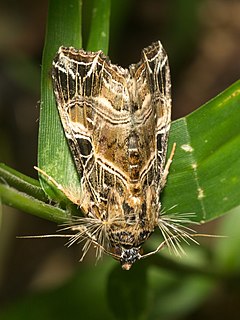
Cepora nerissa, the common gull, is a small to medium-sized butterfly of the family Pieridae, that is, the yellows and whites, which is native to Sri Lanka, India, China, southeast Asia, and Indonesia.

Pachliopta jophon, the Ceylon rose or Sri Lankan rose, is a butterfly found in Sri Lanka that belongs to the swallowtail family. It was earlier classified as a subspecies of Pachliopta hector, the crimson rose.

Eurema laeta, the spotless grass yellow, is a small butterfly of the family Pieridae, which is found in India, Sri Lanka, China, Indochina, Japan, and onwards to Australia.

Cethosia nietneri, the Tamil lacewing, is a species of nymphalid butterfly found in Sri Lanka and south India. The species name is after John Nietner who obtained specimens of the butterfly from Ceylon from which it was described.

Hippotion celerio, the vine hawk-moth or silver-striped hawk-moth, is a moth of the family Sphingidae. It was described by Carl Linnaeus in his 1758 10th edition of Systema Naturae.

Troides darsius, the Sri Lankan birdwing, is a species of birdwing butterfly found in Sri Lanka. It is the largest butterfly on the island and is also the national butterfly of Sri Lanka.

Callopistria rivularis is a species of moth of the family Noctuidae. It is found from the Indo-Australian tropics of India, Sri Lanka up to the Solomon islands and Fiji.

Mythimna irrorata is a moth of the family Noctuidae first described by Frederic Moore in 1881. It is found in the north-western parts of the Himalayas and Sri Lanka.

Leucania loreyi, the cosmopolitan, false army worm or nightfeeding rice armyworm, is a moth of the family Noctuidae. It is found in most of African countries, the Indo-Australian subtropics and tropics of India, Sri Lanka, Myanmar, the eastern Palearctic realm, and the Near East and Middle East. The species was first described by Philogène Auguste Joseph Duponchel in 1827.

Acosmeryx shervillii, the dull forest hawkmoth, is a moth of the family Sphingidae. The species was first described by Jean Baptiste Boisduval in 1875. It is found from the Indian subregion, Sri Lanka, to Sundaland, the Philippines and Sulawesi. Acosmeryx pseudonaga is sometimes treated as a valid species.

Leucophlebia lineata, the large candy-striped hawkmoth, is a moth of the family Sphingidae. It was described by John O. Westwood in 1847. It is known from Sri Lanka, India, Nepal, Thailand, eastern and southern China, Taiwan, Cambodia, Vietnam, Malaysia, Indonesia and the Philippines. It is a minor pest of sugarcane.

Creatonotos gangis is a species of arctiine moth found in South East Asia and Australia. It was described by Carl Linnaeus in his Centuria Insectorum.

Ambulyx substrigilis, the dark-based gliding hawkmoth, is a species of moth of the family Sphingidae. It was described by John O. Westwood in 1847.

Actinotia intermediata is a species of moth of the family Noctuidae. It is found in Asia, including India, Sri Lanka and Taiwan.
Endoclita purpurescens is a species of moth of the family Hepialidae. It was described by Frederic Moore in 1883 and is known from Sri Lanka. Food plants for this species include Camellia and Cinchona.
Ancylolomia chrysographellus, the angled grass moth, is a species of moth in the family Crambidae. It is found on Cyprus and in Kenya, Uganda, Yemen, India, Pakistan, Sri Lanka, Myanmar, China, Korea, Japan, Taiwan, the Philippines and Indonesia.
Micraloa lineola is a moth of the family Erebidae. It was described by Johan Christian Fabricius in 1793. It is found in India, Nepal, Sri Lanka and Myanmar.

Somera viridifusca, the prominent moth, is a moth of the family Notodontidae described by Francis Walker in 1855. It is found in Sri Lanka, Sundaland, the Philippines, Sulawesi, the north-eastern Himalayas, Sikkim in India, Hainan and Yunnan in China and in Taiwan.
Creatonotos interrupta is a moth of the family Erebidae. It was described by Carl Linnaeus in his 1767 12th edition of Systema Naturae. It is often listed as a synonym of Creatonotos gangis, but the identity is unclear.

Eressa confinis is a moth of the family Erebidae. It was described by Francis Walker in 1854. It is found in India, Bhutan, Sri Lanka, Myanmar, Taiwan and China.














